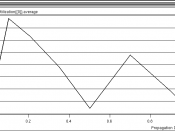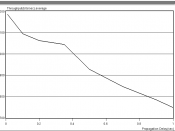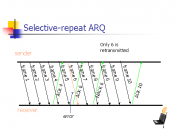Digital Communications and Networking - Laboratory 1 David Luong ""Automatic Repeat Request (ARQ) Protocols" 9916575 �
School of Electrical and Electronic Engineering
Digital Communications and Networking
Laboratory Write-up 1
"Automatic Repeat Request (ARQ) Protocols"
David Luong 991657/5
�
1.2 Preparation
Using a time diagram, describe how Stop-and-Wait operates using positive acknowledgments and timeouts.
This type of transmission is the simplest type ARQ. In this case, there is a sender and a receiver. There is also the assumption that the transmitter has sufficient frames to transmit in order to obtain maximum throroughput.
A stop-and-wait ARQ (Automatic Repeat Query) ensures that each packet transmitted has been received correctly before initiating transmission of the next packet as can been seen in Figure 1. . In other words, the transmitter sends a frame or packet and waits for an ACK (ACKnowledgement or Positive ACKnowledgement) or a NAK (Negative ACKnowledgement) before sending the next packet.
If a response is not received, the transmitter has a time-out mechanism that will retransmit the current packet after a fixed set time. The receiver does not have a time-out when it transmits its ACK or NAK. Packet Transmissions can get lost, have errors, or transmit correctly as can be seen in Figure 1. The delay of transmission can be variable, just like on the Internet.
Using a time diagram, describe how Go-Back-N operates using positive acknowledgments and timeouts.
Go-Back-N ARQ is an error recovery procedure that is used to detect and retransmit a number of frames that have been corrupted due to errors in the physical link. It consists of two nodes: node_0 and node_1 with a duplex link between them.
In this procedure, up to n frames can be continuously sent by the transmitter without waiting for ACKs. Each data unit that is sent is numbered and each...


